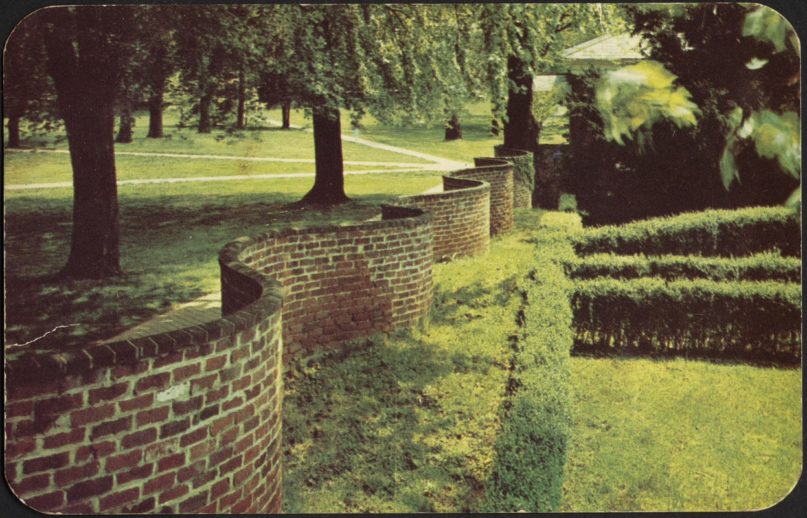(RNS) — In October of 1802, a group of Baptists in Danbury, Connecticut, wrote to President Thomas Jefferson asking that he support their efforts to do away with their state’s Standing Order, which taxed citizens to support the Congregational Church. Jefferson was happy to oblige, writing on January 1, 1803:
Believing with you that religion is a matter which lies solely between Man & his God, that he owes account to none other for his faith or his worship, that the legitimate powers of government reach actions only, & not opinions, I contemplate with sovereign reverence that act of the whole American people which declared that their legislature should “make no law respecting an establishment of religion, or prohibiting the free exercise thereof,” thus building a wall of separation between Church & State.
Over the past few decades, Jefferson’s wall metaphor has come in for plenty of criticism from conservatives — perhaps because, after the Supreme Court decided in the middle of the last century that the First Amendment’s religion clauses applied to the states, something like a wall of separation was indeed built between church and state.
From bans on prayer and Bible reading in public schools to teaching creationism to rules regarding religious displays on public land, the Court embraced the principle that government endorsement of religion, or the appearance of such endorsement, is unconstitutional. Call it the Endorsement Wall.
Today we’re seeing the building of a new wall of separation, this one resulting from a systematic effort to exempt religious institutions and individuals from government rules. Call it the Religious Liberty Wall.
During the last decades of the last century, the Supreme Court under Chief Justices Warren Burger and William Rehnquist took an increasingly expansive view of the government’s right to set bounds on religious liberty.
In the 1982 Bob Jones University case, the Court upheld the right of the IRS to deny tax-exempt status to private schools that practice racial discrimination. In 1986, it denied a Jewish chaplain’s right to wear a yarmulke while on duty and in uniform as a commissioned officer in the Air Force. And in the notorious 1990 peyote case, Employment Division v. Smith, the Court went so far as to assert that Free Exercise claims cannot be made in federal court, challenging neutral laws of general applicability.
But consider what the Court has done under Chief Justice John Roberts.
- In Hosanna Tabor v. EEOC (2012), it decided that religious organizations are exempt from anti-discrimination employment laws when it comes to even lay employees performing ministerial functions.
- In Burwell v. Hobby Lobby (2014), it found that closely held private for-profit companies cannot be compelled to provide contraceptive services under the Affordable Care Act.
- In Trinity Lutheran v. Comer (2017) it ruled that a state cannot bar a religious institution from a government funded program to make playgrounds safer, regardless of a state constitutional ban on aid to religious schools.
- In Masterpiece Cakeshop v. Colorado Civil Rights Commission (2018), it rejected the Colorado Civil Rights Commission’s anti-discrimination decision against a baker who refused to bake a wedding cake for a same-sex wedding.
And this year, a more conservative Court seems poised to further loosen limits on state aid to religious schools.
Meanwhile, since taking office, President Trump has promised to do away with the so-called Johnson Amendment to the federal tax code, which prohibits religious institutions (and other 501(c)(3) organizations) from engaging in electoral politics on pain of losing their non-profit status. At the same time, a growing number of evangelical non-profits are claiming to be churches in order not to have to report the salaries of their top executives.
Such are the bricks in the wall of separation that has been under construction since “religious liberty” became the cri de coeur of the religious right during the Obama years. It’s a wall designed to permit religious conservatives to withdraw into a world of their own, one that permits them to live, work, and worship apart from the gender norms that have come to prevail in the rest of American society — even as their religious institutions insist on, and receive, access to the same governmental benefits as secular organizations.
The 1980s and ’90s were a time when conservative Christians saw themselves as an emerging majority in America. No more. The Religious Liberty Wall is a defensive edifice, intended to enable them to survive like the monks of the Dark Ages until the old-time religion reestablishes a Christian social order.
In his letter to the Danbury Baptists, Jefferson wrote, “I shall see with sincere satisfaction the progress of those sentiments which tend to restore to man all his natural rights” — and indeed, he lived to see the day in 1818 when Connecticut embraced the separationist norms of the First Amendment and got rid of its Standing Order. I doubt the Religious Liberty Wall will prove as impressive, or as durable.






